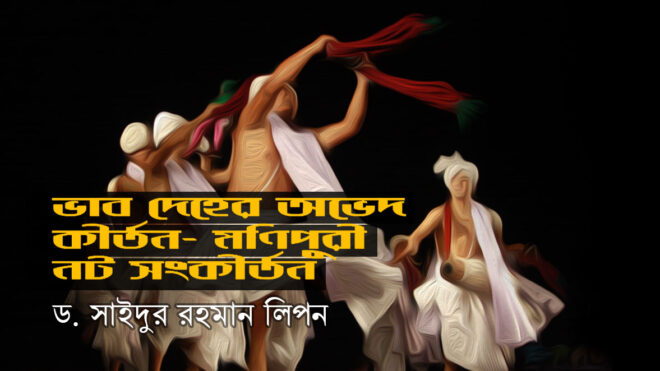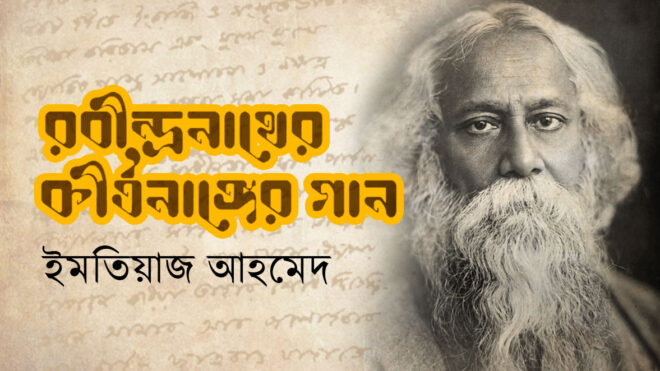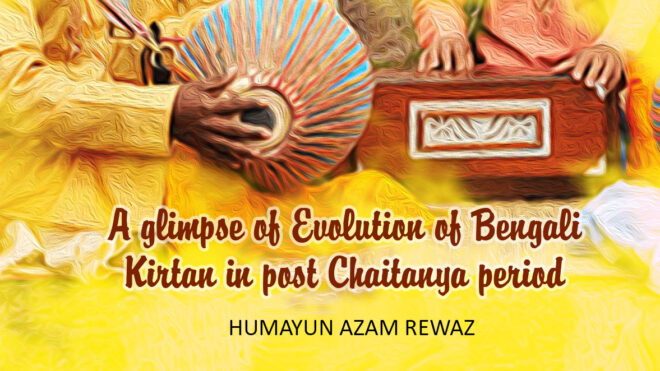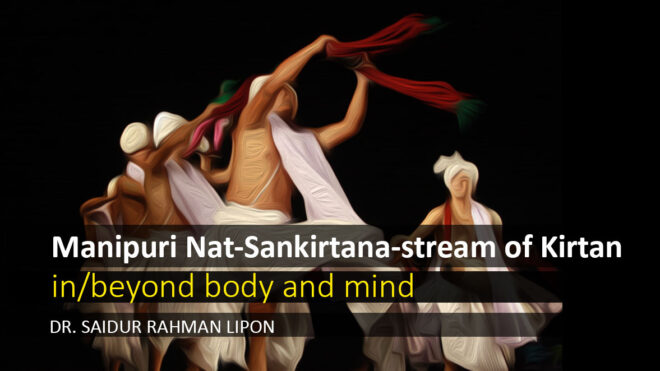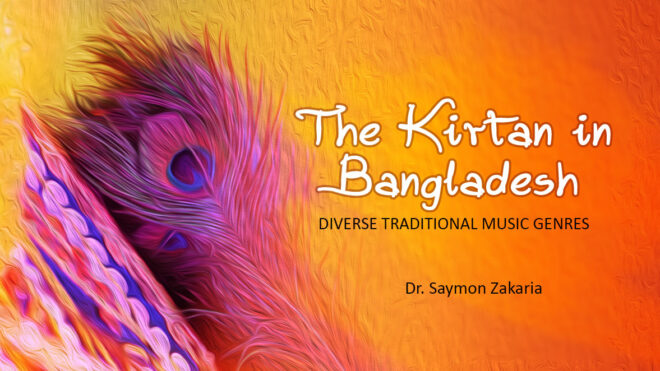Jayati Jayati Dev: Krishna Chaitanya Chandra/JayatiJayati Kirtistasya Nitya Pavitra (Hail to Lord Krishna Chaitanya Chandra/Hail to His Mighty Holy Glory) – Chaitanya Bhagavat
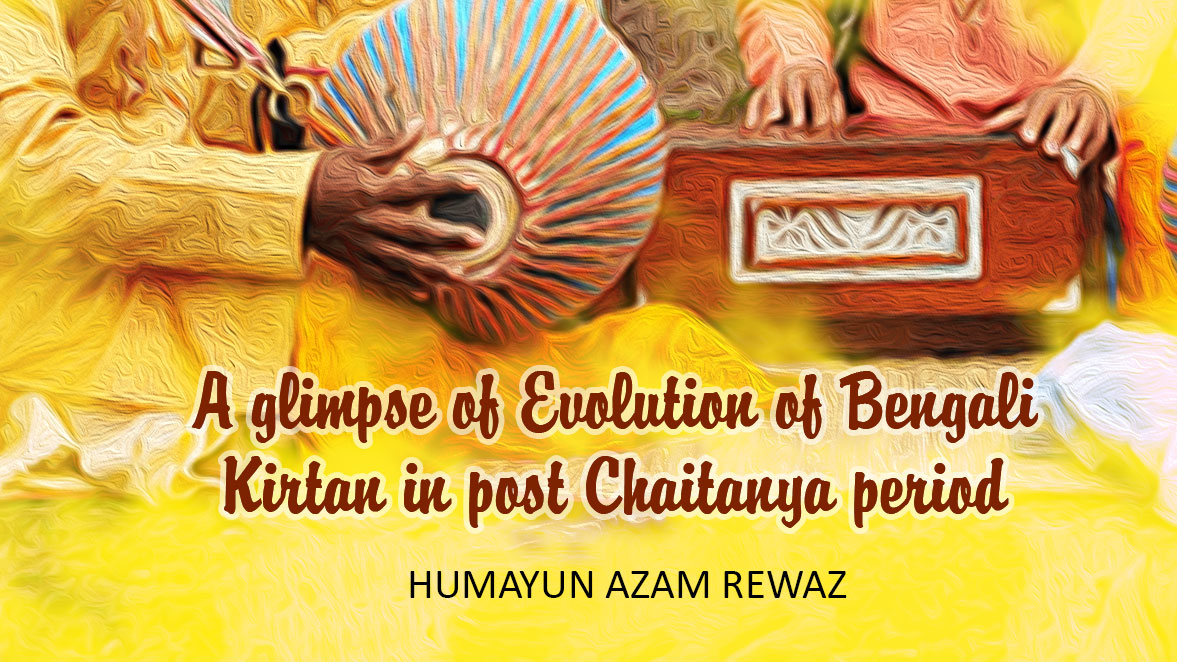
Music is an integral part in the history of social cultural movement in great Bengal. A great variety of songs, performances have emerged as a means of prayer, celebration, even as a way protest both in social life and in religious rituals. In this great interaction, music contains various signs of social and cultural changes in both rural an urban socio-cultural context. This essay aims to focus on onan ancient genre of Bengali song named Kirtan and some traces of its evolution. Inspiration of this reading can be traced to the book titled ‘Bangala Kirtaner Itihash’ by Hitesh Ranjan Sanyal. Though his reading methods and observations were not developed following traditional literary criticism or historical reading methods, this book provide us an exclusive picture of the evolution of Kirtan here with very deep insights. In the foreword of this book, the eminent thinker Gautam Bhadra has pointed out this particular tendency. He highlighted on the era of Bengali Kirtan, dissects it like a dedicated reader and at the same time presents a unique combination of history and literature in his discussion. This book is simultaneously the history of Sri Chaitanyadev’s Bhakti movement and the history of the development of Bengali Kirtan. Suniti Bhusan Kanungo’s ‘Banglar Vaisnab Andolon’, Dr. Hare Krishna Mukhopadyay’s ‘Banglar Kirtan O Kirtania’ almost echo the same way to describe and analysis the Bhakti movement, it’s impact and Kirtan’s evolution to traces the socio-political changes here. Debesh Roy’s ‘Chaitanya Akhyan’ and Farhad Mazhar’s ‘Bhabandolon’ further provide new insights to explore the cultural evolution through post colonial approaches which allow us to check the relationship between sacred and secular music, traces of cultural hegemony, secular movement in colonial situation and its legacy till current century. Reading of ‘Sacred and Secular Musics’ by Virinder S kalra, ‘Secular Music and Secular Theology’ by Tom Beaudoin also makes us aware about the new discourse on sacred music (including Kirtan) from a new perspective including western ideas and theories regarding culture studies. So critical reading of Kirtan as an key instrument of socio-political reformation become evident.
The little-known history of how the masses of rural Bengal built a collective movement in medieval times provide us a complex picture as it comes as myth to some extent and contains both religious and social history as an integral narrative. In the first part of this essay, there is an attempt to read the history of the evolution of Bengali kirtanand in the following part, some recent trends of kirtan developed in the post-Chaitanya period will be analysed. In this episode there will be an attempt to read the new form of Kirtan and Kirtananga songs in the works of Panchakavi, LalanSai, Radharman, Vijay Sarkar and even contemporary lyricists.
There is a detached, self-centered spirit in the Bengali nation. Expanding the individual’s work to create a larger social movement, there is little precedent for its permanence. There are not many exceptions. Hitesh RanjanSanyal has discussed Sri Chaitanya’s appearance, activities and influence while maintaining this regret. During fifteenth-sixteenth century, the process of transformation began in every aspect of Bengali society. The development of Muslim society under Muslim kings was gaining momentum and on the other hand the internal anarchy of Hinduism was disrupting this religious social structure. It became almost impossible to maintain socio-cultural unity and religious structure in Bengali society. AlauddinHussain Shah’s comparatively liberal attitude tried to bring about a harmony in the religious sphere. During this period Sri Chaitanyadeva (1478-1533) emerged with his new Vaishnava philosophy. Contemporary Bengali society and cultural arena got overwhelmed in the tide of this religious philosophy. Chaitanyadeva’s chants of kirtan gathered the large Bengali population in a unified procession of devotion. Later, due to various changes, Kirtan itself is an independent institution today.
The literal meaning of kirtan is chanting, speaking, describing, announcing. ‘Krit’ means praise. ‘Kirti’ and ‘Kirtan’ are words derived from clay. At the hands of Sri Chaitanya, Kirtan has been established with a meaning of its own, transcending its literal meaning. Praising the great characteristics (Mahima Kirtan) of the one who is superior in form, qualities, and valor is Kirtan. In general sense, Kirtan is a music genre performed to describe the glories of Shri Krishna. There is a need to find novelty in the kirtan introduced by Sri Chaitanya. The subject of ‘Kirtan’ is not exclusively ‘Bengal’ in its own right. The kirtans of Jayadeva (twelfth century), Chandidas (fourteenth century) and Vidyapati (fifteenth century) are reminiscent of the classical tradition. However, there is no room for disagreement that Kirtan as a novel musical method has made its debut and established itself only in Bengal. Devotional songs of the saint poet Tukaram also in Maharashtra and Bhagavad music in other parts of India are commonly known as ‘Bhajan’, though the artistic method of Bhajan is distinctively different from Kirtan.
There are reasons to be enthusiastic about this musical genre that arose out of religious rituals. Four hundred years after Sri Chaitanya’s demise, Kirtan is still practiced as a popular genre, and of course the practice has evolved a lot since Chaitanya’s era. Simply put, kirtan is vividly present in our art culture as prayer music of Vaishnava followers, as a popular genre in classical music, as a variant of civic song and above all as Padavali literature. This diversity and multidimensionality is not just a religious sentiment rather a direct and indirect impact of Kirtan.
Achandal adisavare dilo kol
Chaitanya Charitamrita
Abrahma bhariya shuni Hari Hari Bol
It says, even the Lower Caste (Chandal) participating in the commune while chanting Hari Nam. Close reading of this text will show us, how an apparently harmless chanting became an extraordinary political event to abolish the class discrimination. Chaitanyadeva united and empowered the masses in this tide of devotion (bhakti) and emancipate from the control of Samaj Prabhu (social elites) and religious gurus. It can be said that, the absence of this unity and collective force has repeatedly subjected Bengal to colonial rule onward. Politics was not the goal of Chaitanya, but the people of the oppressed, deprived classes got the motivation to join forces.In the ChaitanyaAkhyan, Debesh Roy marked the similar interventions by Ramanda in Nort India, Namdeva in South-West India, Nanak in West India, Kabir in North India, Mirabai in North-West India, Tulsidas in Eastern India, Rabidas in NortIndia. Their individual spirits empowered and enlightened mass people to stand against the religious instituions. Their interventions are noted in the history as bhakti movement. Rise of Matua Movement led by Harichand Thakur (1812–1878) also brought a revolutionary change to change the life of Namasudra and so-called untouchables of then great Bengal. All these great spiritual leaders and social reformists somehow promoted specific music and musical performance which can be broadly categorized as Kirtan and Bhajan. Needless to say, this did not attract those in the top of power structure. This is the novelty of Bengali Kirtan. Question of gender equality, racism, class conflict, social inclusion and a secular movement got its shape though the evolution of Kirtan.The evolution can also be traced quite distinctively in the study of ethnomusicology which might show how Kirtan performance shaped the idea of group performance and its orchestration settings. The traformation of ‘indoor classical music’ tradition to the ‘music for all’ is a revolutionary event in the socio-political history of Bengal and then Indian sub-continent. Music for all, this core essence of secularism is hardly mentioned in the history of our music. Till now there is notion of ignorance regarding the aesthetic supremacy of kirtan and its origin. The uniqueness of Bengali kirtan is that mass people’s participation shaped the trend of kirtan onward. This mass contains people from every sect, cast and social classes’ even people from other religions too. For example, Shuvendu manna explored the emergence of gaudyaVaishnavism in Manipur and its impact on Naasankirtana. He marked that, Manipuri people has incorporated Kirtan as an integral part of their religion and social life. The Manipuris sing kirtans on the sixth day of child birth, name day, at weddings and funerals and other rituals associated with death. When Chandrakirti Sankirtana came in contact with Manipur’s own culture, it flourished and added to the excellence of Vaishnavite art. Bhagyachandra’s contribution towards this excelling of Vaishnavite art is unprecedented. Later, the international fame of Manipuri dance as a part of Vaishnavite art and culture also came as the result of the contributions of Bhagyachandra. Such way, different school of Kirtan was also introduced during eighteenth century. These five schools of Kirtan, Garanhati, Monohorsathi, Reneti, Mandarini and Dhop Kirtan) was quite popular in different aera. The Monohorsathi school has sustained as dominant school till now.
Chaitey, Nitey, Adwai pagol gaan dhoreche /Ore mon node ese
Lalon Sai
Sri Chaitanya, Nityananda and Advaita Acharya, the Bhakti movement got new dimensions through them and Sri Chaitanya was the lifeblood of this movement. Nabadwip, Vrindavan, Puri are the main pilgrimage sites of ChaitanyaVaishnavas. The practice of Sri Chaitanya is different from the practice of various other regions. The three main medieval figures in Bhakti movement were – Vallabhacharya in the North, Sri Chaitanya in Bengal and Sankaradeva in Assam. Even though they are pilgrims on the path of devotion, there is a difference in their journey, reituals and practices. The commonality among theme can be traced as that, their lifestyle became a religion to all. They never challenged, criticized existing religious beliefs and institutions but their lifestyle did much more than that. They appeared as the solution of all worldly and eternal crises.
Very individual relationship with God is the key characteristic of Chaitanya-initiated Raganugamarga. Sri Chaitanya’s kirtan developed into a mandatory religious practice called Nagar Sankirtan. This Krishna Bhakti procession along with dances with drums, cymbals, mridangas, mandiras make the streets of Nabadwip lively. Kirtan music has evolved in many ways. Navadwipa stage kirtan was a vehicle of exuberant dance, full of loud sounds. After taking pilgrimage (sannyas), ChaitanyaDev went to Nilachal. There he was mesmerized by the beauty of the Goswami’s kirtans. Their kirtans were sung like scriptural music. Chaitanya brought the energy of this song from the courtroom of the elite to the masses. During the post-chaitanya period, Narottam Das made great improvements in the singing method of kirtan and popularized various genres of kirtan.
The practical stream of kirtan can be divided into two main categories – Naamkirtan and Leelakirtan or rasa kirtan. NaamKirtan is essentially the presentation of Krishna’s name through the words of the Gita. Sankirtan and Kirtan are synonymous. Chanting Harinaam in a loud voice is Sankirtan. Members of all classes of society gathered in this flow of devotion. On the other hand, songs based on the life of Sri Krishna are Leela Kirtan. Sri Chaitanya’s invented kirtan is an outward expression of his philosophy of love. Now the question can be asked, how original is this novelty of kirtan? What is the influence of kirtan in contemporary Bengal society and religion?
Chaitanya Dev’s philosophy of love and liberality attracted people from lower classes of society. It is necessary to remember that Islam started to spread through the Sufis in this country, albeit slowly, from the eleventh century. The lower caste Hindus who were suffering from insecurity were naturally attracted to the Sufis who brought the message of equality. It became very difficult for the upper caste Hindus to resist the Islam preached throughSufianapractices. Sri Chaitanya realized that the renaissance of Hinduism required breaking down the wall of casteism and presenting its humanitarian appeal. Sri Chaitanya’s new Vaishnava philosophy appeared in a favorable institutionalized form in society and religion with a new revolution. This ideology is the eastern cultural heritage of not only Bengal but the whole of India. Among these, the high-pitched kirtan of Bengal also contains the ornamentation of folk and classical music.
A very close reading of history wilI led us to trace the early awakening stages of the proletariat’smovement in India through the upsurge of kirtan. The movement that kirtan revolutionized was basically linked to the epitome of human consciousness. During post Chaitanya period, this legacy of emotions naturally and gradually subsided but Kirtan did not die out. Crossing the barrier of religious rites, kirtans were greatly admired by lyricists. However, its musical identity did not remain intact in the hands of lyricists. A faint line of kirtaniyas still survives. But the music of Kirtananga (song influned by kirtan) has appeared in a distinct form, especially in Rabindranath Tagore’s Bhaunsingher Padavali. The legacy of Jayadeva, Vidyapati or Baru–Chandidas was revived. Bhanu Singher Padavali is the the most eminent example of music composition in Brajabuli language during the last century. The influence of kirtan is evident in Rabindranath’s fusion (vanga Gaan) songs. The prominent presence of Kazi Nazrul Islam gained immortaility in the history of Bengali music. During his involvement with Letto troupe, he wrote a song called ‘Sada Mon Chahe Madina Jaabo’ ! Another song titled ‘Sei pothe momo mono ajhi dhay’ was also composed in Kirttan style! Let me mention mentioning a few more kirtans/kirtananga songs by various poets composed till last century. Gahano Kusumo Kunja Majhe (Rabindranath Tagore), Hare Krishna Naam Dila (Pulak Bandopadhyay), Vrindavano Bilasini Rai Amader (Govinda Adhikari), Gother Rakhal Bole De Tui, Shono Lo Shono Lo Balika (Kazi Nazrul Islam), Loye Godhan Goshther Kanan (Lalon ), Ami Ki sukhe soi (Vijay Sarkar), Prano Sakhire (Jasim Uddin), Motike Gourange biye de na (Bhaba Pagla ? ), Tomra Kunja Sajao go (Shah Abdul Karim), Bhromor Koio Gia (Radharomon) Tomay Hridmajhare rakhibo (Dwijobhushan), Aha Lal Paguri diye Mathe (Saptapadi Cinema), Krishna Ailo Radhar Kunje (Arkum Shah), Aami Ar Jabona Jole Go Sai (Ramkanai Das) etc.
Now we can see that the dominant genre of Bengali kirtan basicaly potray the tale of Radha-Krishna’s love affair. Duirng post Chaitana period Sri Chainya also become a part of the kirtan which is distinctively termed as ‘Gourchandrika’. It is another attempt to celebrate human life, human relationship and emotion not just as mystic realm of religion. At the same time Kirtan appear as sacred and natural expression of life. I belive, we can correlate the core essence of rennessiance of Europe in a very unique Eastern cultural text. Looking for this secular essence is the core intenintetion of this essay. But it is unfortunate that we have failed to uphold this spirit among mass people and academia, so stylistic Kirtan is socially and widely patronized on as religious practice now. This doesn’t deny that in urban sphere legacy of Kirtan is quite vivid in our modern music, literature and art practices. In present Bangladesh when several incidents increasingly making us concerned about religious and social harmony, close reading of the evolution of Bengali Kirtan may provide us deep insights to check the loopholes, the inner ingrediants of our philosophical thoughts.
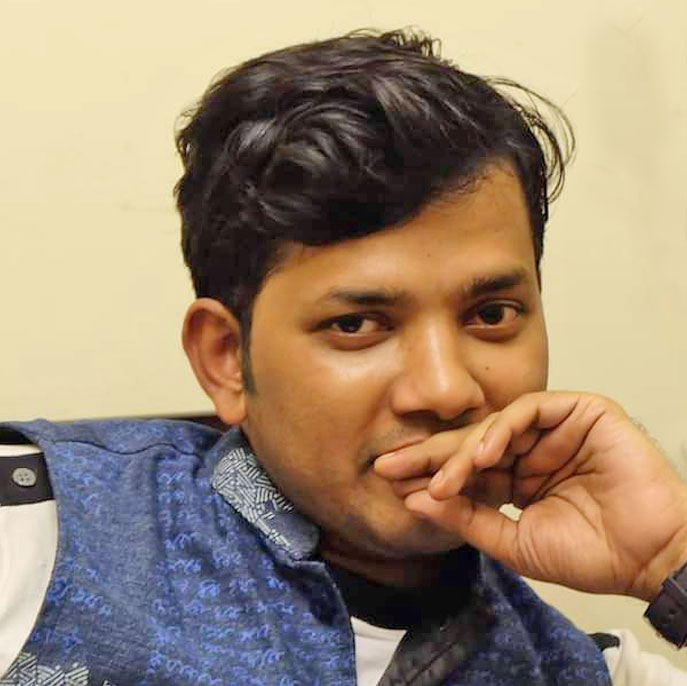
Information of Author
Humayun Azam Rewaz
Dramatist
Bibliography
- History of Bangla Kirtan, Hitesh Ranjan Sanyal
- Sri Chaitanya’s ‘Kirtan’ and Contemporary Society, AKM Shahnewaz
- Movement, FarhadMazhar
- The Emergence of Gaudya Vaishnavsm in Manipur and Its Impact on Nat-Sankirtana
- Banglar Vaisnab Andolon, Suniti Bhusan Kanungo
- Chaitanya Akhyan, Debesh Roy
- Bangalar Kirtan O Kirtaniya, Dr. Hare Krishna Mukhopadyay
- Mrittikar Gaan, Leena Chaki
- Sacred and Secular Musics by Virinder S kalra
- Secular Music and Secular Theology by Tom Beaudoin
